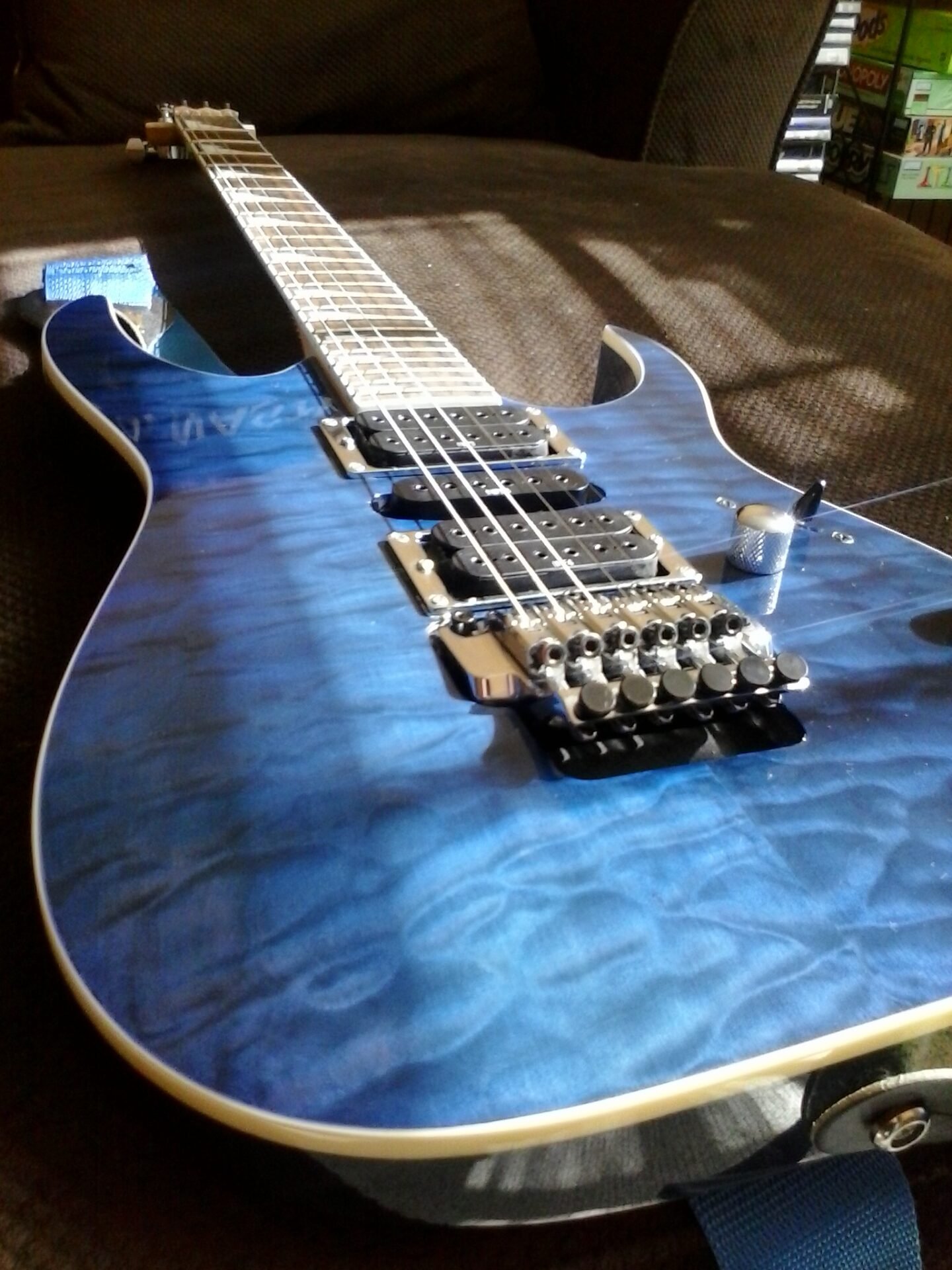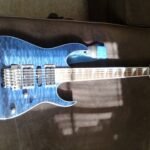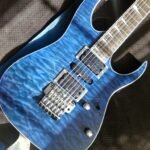On October 31, 2013 I purchased my very first Ibanez RG guitar: an Ibanez RG4EX1 that was my dream guitar at the time (especially the sharktooth inlays)…
The Ibanez RG4EX1: One Year Later
Now, in this Hangout video, I’ve decided to do a “one year later” broadcast on my Ibanez RG4EX1. I can’t believe I’ve had this guitar for a year now, and I STILL LOVE IT! (Scroll below to see a link for my “‘New Guitar’ Hangout & Initial Review” video I created one year ago.)
In the video above, I’ll be discussing some of the pros & cons of this particular model, which is very similar to the Ibanez RG350DX & the Ibanez RG470FM (see link below to shop for Ibanez RG Guitars). I’ll also be demonstrating the great features of the Ibanez RG4EX1 and what I think about the various aspects of these features.
Topics of Discussion
- Tuning stability during dive bombs & bends
- An experiment I tried for additional tuning stability
- My opinions of Floyd-Rose style bridges (an Edge III on this guitar)
- Playability
- My thoughts and recommendations for purchasing similar guitars (accessories, changing strings, which strings have worked best for me, etc.)
This is going to be a great show! I’m just going to kick back and enjoy playing and talking about my awesome RG4EX1 guitar. Here’s hoping you will join me!
Additional Resources
- Shop for Ibanez RG Guitars here on Amazon.
- Watch my “‘New Guitar’ Hangout & Initial Review” video of my Ibanez RG4EX1 one year ago:
- Specs on the Ibanez RG4EX1.
- Ibanez Online Guitar Manual (Various Models).
Check out my pics of my Ibanez RG4EX1 guitar below:
Question: Do you own an Ibanez RG guitar? What are your thoughts about them compared to other guitars? Leave a comment below and tell us all about it.
















I’ve owned an Ibanez RG5EX1, and I currently owned an Ibanez RG4EX1. I bought the RG5EX1 from GC because I liked the pickup configuration (H-S-H)– this offers a lot of flexibility if swapping out pick-ups– it has a Floyd-Rose-type tremolo, and it has a 5-way selector with a control cavity opens up at the back of the guitar (vs. most Fenders, where the control cavity is accessed by removing the pick-guard)– this is good if you want to install a superswitch (5T4P pickup selector), which is a very deep selector switch– too deep for my Yamaha Pacifica, which is a stratocaster-type guitar.
I bought the RG4EX1 (and sold my RG5EX1) because I didn’t like the tone of the RG5EX1– too plain and trebly; the RG4EX1 has a far bassier tone. The only differences between the RG4EX1 and the RG5EX1 that I can tell are the woods (maple+basswood vs. all basswood), the finish (transparent grey burst vs. solid pewter grey), hardware (chrome vs. powder cosmo grey) and the headstock (normal vs. reversed– reverse headstock was cool-looking); otherwise, they’re pretty much the same guitar. So I think the tone difference is probably due to the maple top.
I prefer the unplugged tone of the Yamaha Pacifica over both of the RGs, but the RG4EX1 is still good, though on the bassy side of the things; the RG5EX1 was a little too trebly and too plain. I don’t like the tone of the RG4EX1 through the pickups, because it tends to come out muddled and overly bassy; but I think this is correctable, b/c tone is there when unplugged. I normally use positions 1 and 5 on the guitar; the middle pickup is too noisy for me, and positions 2 and 4 aren’t interesting enough.
My first electric is a Yamaha Pacifica (I don’t know which model), and I quickly swapped out the pickups w/ Seymour Duncans: JB Jr. in the neck, Duckbucker in the middle, Little ’59 in the bridge. I liked the sound of all three pickups by themselves, but I found out the hard way that the Duckbucker does not mix well with the other two pickups– must be some serious impedance mismatch. If you’re wondering, I found the JB Jr. to be more of a Jazz/rock/bluesy type of pickup, the Duckbucker lives up to its name as a single-coil replacement w/ quack, and the Little ’59 has a twangish country sound that is also useful for certain genres of rock. Unfortunately, the control cavity is too shallow for a superswitch, so I couldn’t make the mods I wanted to make to bring out the different ways of combining the pickups; that’s why I bought the Ibanez RG.
There are some things I wanted to experiment with in the near future to improve the sound of the Ibanez RG:
1. Replace the tremolo claw and/or tremolo block w/ a brass or titanium version, to see if that will brighten the tone.
2. While I’m at it, replace the tremolo springs w/ a noiseless spring and replace the strings w/ half-rounds (to eliminate noise when moving up and down the fretboard).
3. Replace the middle pickup with the Little ’59 and rewire the pickups to use the superswitch (plus some other wiring mods).
Wow, this is some great info! Thanks so much for sharing!
(Hopefully this comment isn’t too long…)
It’s been a while, and I’ve tried the things mentioned above:
1. I got the info on the JB Jr. and Little ’59 backwards; the JB Jr. had a twangish country sound, and the Little ’59 was more Jazz/rock/blues.
2. I tried both of those pickups in the middle position of the RG4EX1:
a. JB Jr. – It was just okay. It didn’t have the country twang vs. when it was in the bridge position of my Yamaha Pacifica (stratocaster); it didn’t stand out on its own, and sounded more similar to the stock INF pickups. I ended up swapping it out for the Little ’59.
b. Little ’59 – A little bit more distinctive than the JB Jr., though not as good sounding as when it was in the neck position of my Yamaha Pacifica. I don’t know how to describe it except that it sounds like a lesser quality ’59 pickup. Perhaps in the future, I might try moving it to the neck position, or else replace it with a full-size Seymour Duncan ’59 or a Gibson Burstbucker or ’57 pickup.
3. I replaced the tremolo block w/ a brass block; definitely worth every penny. It improved the sustain and the tone, giving it a fuller sound– perhaps better lows, more clear across the spectrum.
* Note: The FU-Tone big brass tremolo block is so big, it prevents me from pulling up on the tremolo (which I very rarely do); to fix this, addition routing is needed (which I haven’t tried yet). The tremolo still works in the diving direction (which is fine for me), so I left the tremolo cavity as-is.
4. I replaced the tremolo claw w/ a titanium claw. I didn’t notice much difference in the tone, albeit it’s comforting knowing that the claw and the titanium screws should last beyond the life of the guitar.
5. I added noiseless springs, and they seem to help reduce the amount of noise from the springs– I have no complaints about it, which is a good sign.
6. I didn’t try the half-rounds, but instead switched to D’Addario NYXL Super Light strings, of which I have no complaints.
7. I swapped the tone pot for a push-pull pot. It still functions as a tone pot, but the push-pull mechanism controlled the mode of operation for the middle pickup:
a. At first, I tried using the push-pull as a series-parallel switch for the north and south coils of the middle pickup (which was a JB Jr. at the time):
i. When pushed in, the north and south coils of the JB Jr. were in series, which is the normal way humbuckers are wired.
ii. When pulled out, the north and south coils were in parallel; this made the JB Jr. sound more single-coil-ish, that is, less fat, sort of glass-y
b. The series-parallel switch was not that useful, so I rewired it to function as a in-phase/out-of-phase switch (and I also replaced the JB Jr. w/ the Little ’59):
i. When pushed in, the middle pickup was in-phase relative to the neck and/or bridge pickups, which is the normal thing to do when combining two or more humbuckers.
ii. When pulled out, the middle pickup was out-of-phase relative to the neck and/or bridge pickups; this resulted in a thinner, more trebly sound, perhaps useful if trying something more Hendrix-y
8. Finally, I added the superswitch (5-throw, 4-pole switch) and replaced the volume pot with a push-pull pot (actually, a push-push pot, which is more convenient). The volume pot still functions as a volume pot, but the push-push switch + the superswitch allowed for 5 additional pickup combinations:
a. When pushed in, the superswitch is a standard 5-way selector:
* Position 1 = N (the neck pickup currently is the stock INF-3)
* Position 2 = N+M
* Position 3 = M (the middle pickup currently is the Seymour Duncan Little ’59)
* Position 4 = M+B
* Position 5 = B (the neck pickup currently is the stock INF-4)
b. When popped out/up, the superswitch provided 5 different pickup combos:
* Position 1 = NxB – The neck pickup is in series with the bridge pickup
> This is very beefy, with pronounced lows/fundamental tones
* Position 2 = (N+M)xB – The neck and middle pickups are in parallel, and both are in series with the bridge pickup
> When the middle pickup is in-phase, this is also a very beefy
> When the middle pickup is out-of-phase, this sounded like a normal pickup but with more color/overtones, which is more likely to make the amp growl/squeal– I use this setting a lot
* Position 3 = MxB – The middle pickup is in series with the bridge pickup
> This is very beefy, but slightly less than in position 1 (NxB)
* Position 4 = N+M+B – The neck, middle and bridge pickups are all selected (in parallel to each other)
> This is the most plain/clean sounding of all of the possible pickup combinations
* Position 5 = N+B – The neck and bridge pickups are selected (in parallel to each other)
> This has characteristics of both pickups, which is clear and present lows, a little bell-like/twang-ish highs; it’s probably the most telecaster-sounding of all of the pickup combinations
c. Overall, with the above wiring mods, I find myself using these combinations the most:
i. N – I feel like the stock INF-3 is the most piano-like, which is useful for cleaner/rounder solo sounds
ii. (N-M)xB – This is position 2 with the push-push and push-pull pots both in the “up” position; it’s a nice humbucker sound with more color/grit than the stock INF-3
iii. B – I think the stock INF-3 has more pronounced mids and less lows, which at times is useful when soloing
iv. N+B – The combination of the INF-3 neck and INF-4 bridge pickups has a certain telecaster-twang to it, which is sometimes called for in certain songs
iv. N+M or M+B – If I don’t want the full-on stock INF-3 or INF-4 sound, position 2 or 4, respectively, are good alternatives
v. M – I sometimes use the Little ’59 by itself, I think b/c it’s more scooped (more highs and lows, less mids), which I think leads to a certain clarity for certain solos
d. Aside from the (N-M)xB pickup combination, I normally don’t use the Little ’59 out-of-phase w/ other pickups; whenever I try those other out-of-phase pickup combinations in a band-rehearsal, it doesn’t sit well in the mix, I think due to not having enough lows+mids/fundamental tones, and so I end up switching to an in-phase pickup combination or the (N-M)xB pickup combination. I very rarely use fuzz or heavy distortion; perhaps an out-of-phase pickup combination might work better in those type of situations.
These are some of the items I still wanted to try out:
1. Add 1 or 2 Kinman pickups (an Impersonator 54 in the bridge position, and possibly a Woodstock/AVn-69 in the middle/neck position); this should add more single-coil-ish sound options.
* To accomodate the additional pickup(s), I would add 1 or 2 Free-way Ultra switches, which look like a 3-way toggle switch (similar to what’s in a Les Paul), but is actually a 6-way toggle switch
* I would convert the existing tone control into a volume control just for the Kinman pickup(s); that way, I could blend the Kinman pickup(s) with the other pickups
* Also, I would add 2 concentric/stacked pots, one for the Kinman pickup(s), one for the other pickups; for each concentric/stacked pot, the upper pot would be a standard treble-cut control, and the lower pot would be a bass-cut control.
2. If I add a Kinman Impersonator 54 in the bridge position, I would also add the JB Jr. to the bridge position, since both pickups should fit in the slot with minimal routing; that way, I still have a sound similar to the INF-4 while adding a 54 Fender sound as well.
* Later on, I’d like to swap the JB Jr. in the bridge with a Zexcoil Juicy Bucker, which is also single-coil-sized but sounds very much like a full-sized humbucker, similar to a full-size JB pickup; it should sound even better/fuller than the JB Jr.
3. If I add a Kinman Woodstock/AVn-69 pickup in the middle/neck position, in order to make room for the new pickups, I might try and replace the INF-3 with a Dimarzio Pro Track, another single-coil-sized pickup, which hopefully sounds similar to the INF-3, and maybe also move the Little ’59 to the neck position, which should make it sound better as a rock/jazz/blues pickup by adding more lows/fundamental tone.
4. If the Little ’59 doesn’t work out in the neck position, I might try replacing it full-size Seymour Duncan ’59, Gibson Burstbucker or Gibson Classic ’57 pickup, possibly routing the guitar to handle a full-size humbucker or two single-coil-sized pickups in the middle slot.
5. I might replace the Ibanez Edge III tremolo w/ a Gotoh GE-1996T Floyd Rose tremolo, which is supposedly better constructed and has very good tremolo bridge posts, which apparently has an effect on the tone and sustain
6. I’ll probably add a strap lock system, at some point, to avoid accidents.
Of course, the main obstacle to doing the above is the wallet. =P
Wallet indeed! Great setup all around. I prefer DiMarzio pickups myself. My favorite is the ToneZone. I have the ToneZoneS on my main Strat in the bridge position and it’s crystal clear on lead and chords as well.
Would love to have more mods done on my guitars, but like you it’s all a matter of good ol’ greenbacks. Thanks for sharing.
I’m super late to the party, but can anyone confirm the gotoh ge1996t is a direct drop in? I know the it will need drilled out for the locking studs but I’m worried about the fitment inside the recess/cavity?
Unlike the tremsetter, you won’t need to drill an extra hole up where the claw sits to make room for a rod. The Backbox installs directly. All you need to do is make sure there’s no more than 4 springs in the tremolo cavity, and you’re good to go. Thanks for commenting!
I’m sorry, I must be confused. What does a tremsetter have to do with whether a gotoh bridge will fit into the RG4EX1 cavity? Any chance you know if the gotoh trem will fit?